|
|
Large Brown Mantid - Archimantis latistyla
Family MANTIDAE
This page contains information and pictures about Large Brown Mantids that we found in the Brisbane area, Queensland, Australia.

- Female, length 120mm
They are also know as Stick Mantis. This Praying Mantid is common in Brisbane. We can find them when they are hunting other insects among plants. This mantids is pale brown in colour and looks like a dry leave among the grass. There are two black dots on each side of its forewings. Females have half length wings which cover half of her abdomen. Males are smaller in size, have full length wings.

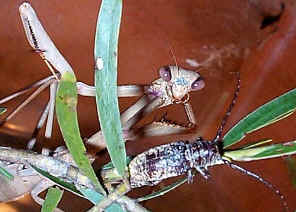
- We took the first picture when we were trying to took some dragonflies pictures. The Mantid was waiting on a spot on the edge of a pond where the dragonflies may land for a rest. We sometimes find this Praying Mantid in our backyard hunting for pray. The second picture showing the mantids about to attack a Longicorn beetle.


- We sometimes saw them hide beside a shop window waiting for the insects attracted by window light.
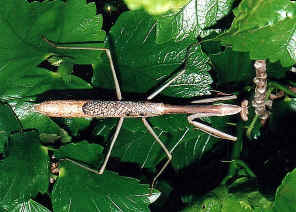

- Praying Mantids have very good eye-sight and a flexible neck. It bended its head and looked at me when we took those pictures.
-
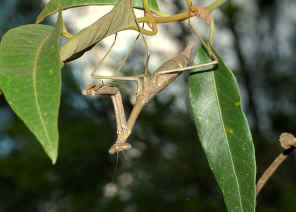

- Notice the blue marking on its head. Some other mantid species have the blue markings on their front pair of legs. Blue colour may mean something in mantid, could be highly sensitive to mantid's eyes.
-
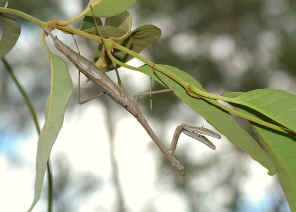

Nymph
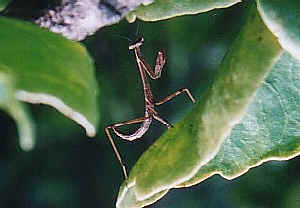

- Nymph, length 30mm and 40mm


- Nymph, length 90mm
- In the first picture the Praying Mantid nymph look like a young Large Brown Mantids, but not exactly sure. We found it hunting in the Hibiscus plants for the Clown Bugs. Mantids are developed in in-complete metamorphosis. The second picture shows another Large Brown Mantids nymph.
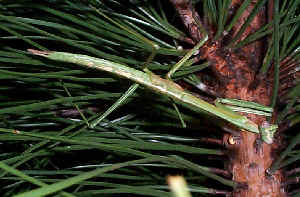
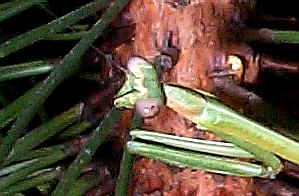
- Nymph, length 90mm
- We found that some nymph Large Brown Mantids are green in colour. This nymph hunting for pray on the pine tree in our garden. Also notice the white stripe on its back, it is the characteristic of Large Brown Mantid nymph.
Ootheca
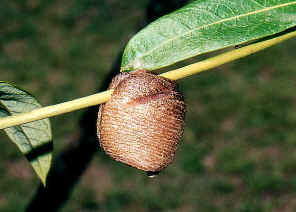

- Ootheca - mantids eggs case . Female mantid lays up to few hundred eggs in a distinctive case called ootheca. The young nymphs hatch from the ootheca. The ootheca is constructed of moist formed material produce by the mantid. This becomes a spongy ball on drying.
The Praying Mantid eggs are suffered from parasitise by Parasitic Wasps. The small holes (second picture above) were made by those wasps when they emerged.
Mantids Hatching from Ootheca
On a late winter we found a newly made Ootheca on a plant. There were two Parasitic Wasps (Podagrion sp.) trying to insert their eggs into the Ootheca. The two wasps are black in colour with body length about 5mm. They both had the very long ovipositor, more than three times of their body length. The two wasps flied away before we pointed our camera at them.
Anyways, we took the Ootheca back home to see what would happen. About three weeks later, we saw many young mantids emerged from the Ootheca. They came out one by one, look like a small worm, 10mm long and pale brown in colour. They had the first moulting immediately outside the Ootheca. Then their appearance become exactly like their mother, except much smaller. In the about picture you can see many empty skin cases left after their moulting. Watch more carefully you can see one young mantid just emerging and few others still struggling in the moulting process.
There were about a hundred of young mantids emerged. Some rested on the plant and some actively ran around. We did not see any cannibalism, could be they were not too hungry yet. After watching them for two days, seemed no more interesting things will happen, we put them back into our backyard.
Beside the the emerged of the young mantids, we also see a few parasitic wasps came out. They came out by making a small hole on the side of the Ootheca. They look exactly as the two wasps that we mentioned above except none of them had the long ovipositor. We might see the male wasps emerged only. As their mothers, they flied away quickly and, again, we failed to take any picture of them.
- Reference and links:
- 1. Insects of Australia, CSIRO, Division of Entomology, Melbourne University Press, 2nd Edition 1991, p 356.
- 2. Insects of Australia and New Zealand - R. J. Tillyard, Angus & Robertson, Ltd, Sydney, 1926, p93.
- 3. Wildlife of Greater Brisbane - Published by Queensland Museum 1995, p73.
- 1. Insects of Australia, CSIRO, Division of Entomology, Melbourne University Press, 2nd Edition 1991, p 356.


